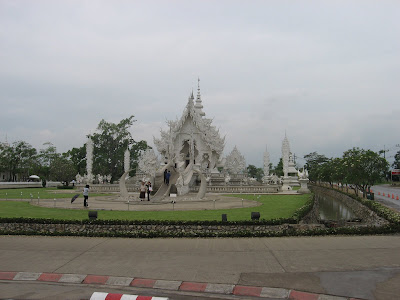Wat Rong Khun, the White Temple near Chiang-Rai is designed by the respected Thai artist Chalermchai Kositpipat.

Words fail me in trying to describe the meanings behind the architecture of this wondrous temple, so I have borrowed the words of the artist himself from his website:
"MEANINGS OF THE MAIN BUILDING
It was my strong intention to build a temple in imitation of heaven. I wanted it to be a heaven on earth.
I built a main building in the Buddhist monastery. I wanted it to be like a house of the Buddha with white color representing His purity and white glass representing His wisdom shining all over the earth and the universe.
The bridge symbolizes transition from the cycle of life to the land of the Buddha. In front of the bridge is a small semicircle, representing the world. The large semicircle with the demon king’s fangs embodies passion and desire. We need to throw our passion and desire away into the mouth of the demon king to clean ourselves before going inside the main building. On each rail of the bridge are 8 monsters, totaling 16 monsters representing 16 types of passion. The middle of the bridge symbolizes Sumeru Mountain, which is the habitation of gods. The pond below stands for Sithandorn Ocean. Above the 6-layer heaven is the 16-layer Brahma’s land, represented by 16 magic lotuses surrounding the main building. The 4 biggest ones located beside the entry to the main building represent the shelters of the 4 great followers of the Buddha – Sodaban, Sakitakami, Anakami and Orahan.
The semicircular in front of the stairway to the main building symbolizes the transcendental world of wisdom. The three steps of the stairway represent impermanence, sadness and non-selfness. Next to the stairway is the land of the formless divine represented by 4 magic lotuses and 4 doors. The last door contains triangular mirrors, representing emptiness (nothingness). Next to the door is the threshold to the land of the Buddha.
On the 4-sided walls and the floor inside the main building are mural paintings in gold color, representing the release from passion and desire to the world of Dharma.
I use the main apex to symbolize Buddhist Commandments. The apex comprises 4 animals representing the 4 elements of the earth; elephant representing land, naga representing water, swan representing wind and lion representing fire. All these animals are on their duty; to safeguard Buddhism. Thus, the main apex comprising the 4 elements of the earth symbolizes the 5 Commandments, the 8 Commandments, the 10 Commandments, the 227 Commandments and 84,000 codes of morality.
The apex on the second level refers to consciousness represented by 2 animals: naga and swan. While the naga’s fangs symbolize evil, the swan symbolizes virtue. With the use of Buddhist Commandments, evil (passion) is killed. When we win over passion, sonsciousness occurs thus finally leading to wisdom.
The top apex symbolizes wisdom represented by swan with garuda’s mouth crouching still. The swan seems not having any kind of passion but nothingness.
Behind the top apex are a group of 7 designs representing the 7 Elements of Enlightenment and a group of 8 designs on the foundation of the umbrella representing the 8 Paths of Buddhism. The multi-tier umbrella itself symbolizes Nirvana.The pedestal below the top roof represents the 10 Fetters.
On each pillar on the 4 corners of the main building are the flags representing respect paid to the Buddha according to the belief of the Lanna Region.
Said above is only a short description of the main building. In fact, there is a lot more information as I plan to build 9 main buildings in total, each having Buddhist meanings.
I want to create Buddhist arts on our land that are so great and splendid that the people around the world want to see them. I will dedicate all my life to this work. Also, I have at least 2 generations to continue it after my death. I estimate that it will take about 60-70 years to complete 9 main buildings."
Below are some photo's we took while visiting. The scheduled stop was for half an hour but Lidy and Russell were so intrigued that they overstayed for an hour and a half more.Russell inspects the Temple grounds
Another view
Lidy and Nonny inspect the intricate work on the fence
Artists apprenticed to Chalermchai Kositpipat work on the intricate carvings
The visit to the White Temple has been a highlight of our trip and we highly recommend that you take the time visit it the next time you are in Thailand.













No comments:
Post a Comment